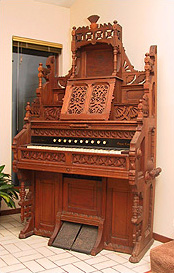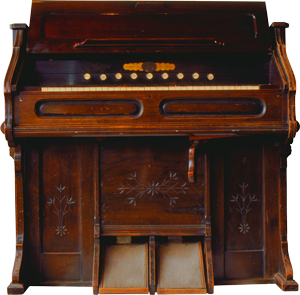
THE FIRST THING YOU NOTICE ABOUT A REED ORGAN IS THE ELABORATELY CARVED CABINET. Sometimes standing six to eight feet tall, they usually have one keyboard, with stops above it, and treadles below which pump the organ. Built from the 1850s to the beginning of World War I, the reed organ should not be confused with the electronic organs popular in the 50s, 60s and 70s. Rechel Piano Company repairs, services, rebuilds and refinishes these elegant instruments.
Please call or e-mail us to schedule an appointment or ask a question not answered below.
It won’t have a cord to plug it into the wall. Reed Organs are pumped with the feet, like a player piano. The only exceptions are very large reed organs (which often have foot pedals like a pipe organ) and a reed organ with an after market blower, which would have a cord, but would still has the foot treadles for pumping.
Yes, we manufacture small electric centrifugal blowers for reed organs. They create the same vacuum that the foot treadles would for operating the organ. The blower contains a one way valve, so that you may operate the reed organ by either pumping with your feet, or turning on the blower.
Rechel Piano can replace any missing faces (labels) on the organ stops. We also have many reed organ manufacturers’ lists of different stop names and their function, so that we might accurately replace faces where the original stop name is gone.
Many materials used in the construction of the reed organ tend to disintegrate with age. These include the bellows cloth (rubber covered cotton twill), and the leather in gaskets. Many times these materials have developed sufficient leaks that the organ can no longer hold the vacuum which it uses to make the reeds sound. These reeds can also become clogged with dirt or debris, and stop sounding. In all these cases, Rechel Piano Company can restore your reed organ to allow it to be easily played once again.

We strive to have a service technician available to answer the phone 9 to noon, E.S.T., weekdays. At other times, they will answer if they are available, but they may be doing restorations or be in the field. At these times, please leave a message and we will respond as soon as possible.